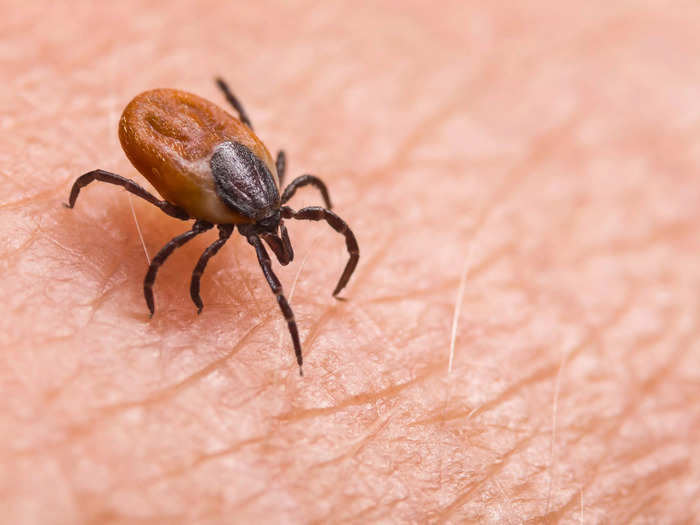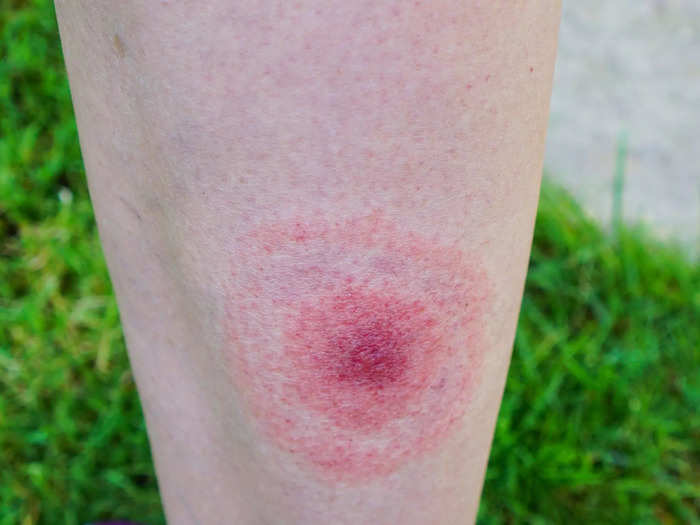Lyme disease is the most common tick-borne illness in the US, and it's probably under-diagnosed.
Deer ticks can cause Lyme disease if left untreated. Photon Illustration/Stocktrek Images/Getty Images
Approximately 35,000 cases of Lyme disease, an infection transmitted by ticks, are reported to the US Centers for Disease Control and Prevention each year. The illness is primarily spread by the bite of blacklegged ticks infected with Borrelia burgdorferi bacteria.
However, estimates based on insurance claims show that more than ten times that number — about 476,000 people — are diagnosed and treated for Lyme disease each year, even if they don't report it directly to the CDC.
Lyme disease can also be tricky to diagnose, as many of the symptoms can occur with other infections. Doctors may consider your lifestyle, as well as the region where you live to determine if you're likely to have been exposed to blacklegged ticks. Also known as deer ticks, the insects are local to the northeast and have spread southward and to parts of the Midwest.
Here are five physical signs to look out for if you are at risk of contracting Lyme disease.
You have a 'bull's eye' rash.
anakopa/Getty Images
A telltale sign of a tick bite is an expanding red rash that looks like a target, insect expert Jim Fredericks told Insider.
This "bull's-eye" rash, also known as Erythema migrans, occurs in about 70 to 90% of Lyme disease cases, Fredericks said. The rash typically starts as a small red spot that expands over a period of days or weeks, with a central clearing giving it a bull's-eye appearance.
The rash can grow up to 12 inches in diameter, according to the CDC. It may feel warm to touch, but reports suggest it's not particularly itchy or painful.
Fredericks, the chief entomologist at the National Pest Management Association, said that it's important to do a full-body check for ticks after spending time outside, and to seek medical attention if you suspect a tick has bitten you, before your symptoms progress.
You have a fever and chills, but it's not the flu or COVID-19.
Boris Zhitkov/Getty Images
Other common symptoms of Lyme disease include fever, chills, and body aches.
If that trio sounds familiar, it's because the symptoms can appear after any infection, such as COVID-19 or the flu. You can get tested at a doctor's office to rule out other illnesses, but antibodies for Lyme disease typically don't show up on tests for weeks after infection, according to the CDC.
Fredericks recommended checking for the bull's-eye rash (and considering whether you've been in the woods recently) to set early Lyme disease symptoms apart from something like the flu.
Your joints ache, even weeks after a suspected tick bite.
Lyme disease may cause joint pain and can progress to chronic arthritis. krisanapong detraphiphat/Getty Images
Symptoms of Lyme disease can escalate if the illness is not spotted early and treated with antibiotics.
After several weeks of being infected with Lyme disease, approximately 60 percent of people not treated with antibiotics develop joint pain, Fredericks told Insider. This may look like recurrent attacks of painful and swollen joints, especially larger joints like the knees.
About a quarter of Lyme disease cases reported to the CDC — which may be among the most severe — progress to arthritis, which can permanently damage affected joints if left untreated, according to the agency. People may also experience episodes of pain in the muscles, tendons, and bones.
You have severe headaches or neck pain.
Head and neck pain could be a sign of Lyme disease. andriano_cz/iStock via Getty Images
If not treated, the bacteria that cause Lyme disease can spread throughout the body and cause wide-ranging symptoms of infection. This may include overall fatigue, headaches, sensitivity to light, and pain or stiffness in the neck.
As the infection makes its way through the nervous system, individuals with Lyme may report increasingly rare and severe symptoms.
According to the CDC, approximately nine out of every 100 reported Lyme disease cases involve temporary facial paralysis, and about four develop nerve pain or numbness in their hands or feet.
A small percentage of cases progress to cause serious inflammation in the brain or spinal cord (3%) or the heart (1%).
You can't seem to get enough sleep.
Chronic fatigue may result from untreated Lyme disease. Catherine McQueen/Getty Images
Chronic fatigue is commonly associated with Lyme disease.
More subtle changes such as memory loss, difficulty with concentration, and a change in mood or sleeping habits have also been associated with Lyme disease, Fredericks told Insider.
Trouble with memory, mood, or sleep may persist for years if the disease is left to progress.






